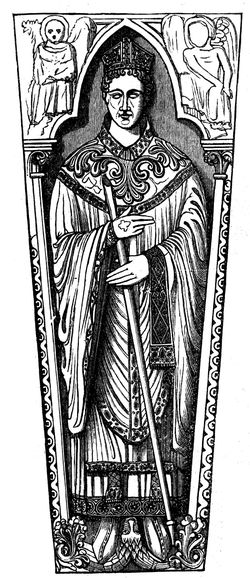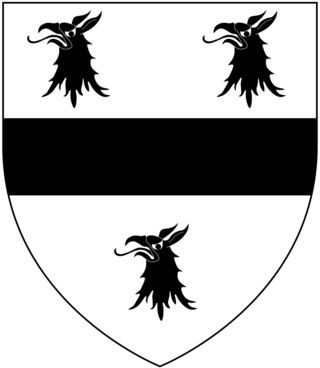Related Research Articles

Exeter Cathedral, properly known as the Cathedral Church of Saint Peter in Exeter, is an Anglican cathedral, and the seat of the Bishop of Exeter, in the city of Exeter, Devon, in South West England. The present building was complete by about 1400 and has several notable features, including an early set of misericords, an astronomical clock and the longest uninterrupted medieval stone vaulted ceiling in the world.

Simon of Apulia was an Italian-born canon lawyer who served as Bishop of Exeter in Devon, England, from 1214 until his death in 1223.

John Hales was Bishop of Coventry and Lichfield (1459-1490). He was one of the Worthies of Devon of the biographer John Prince (d.1723).
Henry Marshal was a medieval Dean of York and Bishop of Exeter. He was a younger son of John Marshal and his wife Sybilla of Salisbury, and thus a younger brother of William Marshal and a member of the Marshal family.

The Dean of Exeter is the head of the Chapter of Cathedral Church of Saint Peter in Exeter, England. The chapter was established by William Briwere, Bishop of Exeter (1224–44) who set up the offices of dean and chancellor of Exeter Cathedral, allowing the chapter to elect those officers. The deanery is at 10 The Close, Exeter. The current dean is Jonathan Greener.
Events from the 1280s in England.
Keith Brynmor Jones is a retired Church of England priest. He was the Dean of Exeter from 1996 to 2004, and the Dean of York from 2004 until his retirement in 2012.
Serlo was Dean of Exeter between 1225 and 1231. He is buried at Exeter Cathedral. Previously he had been Rector of Colaton Raleigh.

Cyril Jonathan Meyrick is a British Anglican retired bishop. He is a former Bishop of Lynn and Dean of Exeter.
Roger de Wynkleigh was Dean of Exeter between 1231 and 1252.
William De Stanwey was Dean of Exeter between 1231 and 1252.

William Buller (1735–1796) was an English clergyman who served as Bishop of Exeter from 1792 to 1796.
Clifford Thomas Chapman FKC was an Anglican priest. He was the Dean of Exeter in the Church of England from 1973 to 1980. Chapman was educated at Sir Walter St John’s School and King's College London. He was ordained in 1937 and began his ministry with curacies at All Saints' Child’s Hill and St Paul’s Winchmore Hill. After this he was the minister of the Church of Ascension Conventional District, Preston Road, Wembley and then the Rural Dean of Chelsea. From 1950 to 1961 he was the Rector of Abinger and from then until his appointment as the Dean of Exeter in 1973 he was a residentiary canon of Guildford Cathedral.
Marcus Knight FKC was an Anglican priest. He was the Dean of Exeter in the Church of England from 1960 to 1972.
Alexander Ross Wallace was an English priest, colonial administrator, and author. He was the Dean of Exeter in the Church of England from 1950 to 1960.

Jonathan Lee Draper is an American Anglican priest, theologian, and academic. Since 2017, he has been the general secretary of Modern Church. From 2012 to 2017, he was the dean of Exeter, at Exeter Cathedral in the Church of England Diocese of Exeter.
Andrew de Kilkenny was Dean of Exeter between 1283 and 1302.

Alured Clarke (1696–1742) was Dean of Exeter between 1741 and 1742.

The area of Cathedral Close, Exeter has been in the centre of Exeter, Devon, England, since Roman times when there was a basilica and a bath house in this area. A church was established here by the seventh century when a young Saint Boniface came from Crediton to study. The area was walled after 1283 and seven gates into the yard were created. The gates included one at St Petrocks and the original grand entrance into the yard – Broadgate. This created the cathedral close.

Exeter Cathedral School (ECS) is a 3–13 mixed, Church of England, private day and boarding choir and preparatory school in Exeter, Devon, England. It has been closely associated with Exeter Cathedral since it was first recorded as existing in the 12th century.
References
- ↑ Radford, Ursula (1955). "An Introduction to the Deans of Exeter". Report & Transactions of the Devonshire Association. 87: 1–24.
- ↑ "A short history of Exeter Cathedral". Exeter Memories. Retrieved 22 January 2017.
